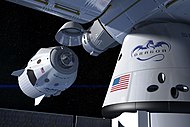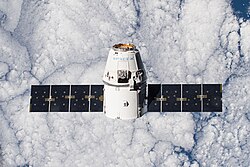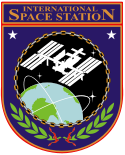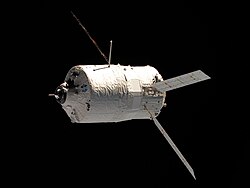SpX-DM1
| SpX-DM1 | |||
 | |||
| Statistik för uppdraget | |||
|---|---|---|---|
| NSSDC-ID | 2019-011A[1] | ||
| Modell | Dragon 2 | ||
| Beställare | NASA | ||
| Operatör | SpaceX | ||
| Varaktighet | 6 dagar, 5 timmar, 56 minuter, 5 sekunder | ||
| Uppskjutning | |||
| Raket | Falcon 9 Block 5 | ||
| Uppskjutningsramp | Kennedy LC-39A | ||
| Uppskjutning | 2 mars 2019, 07:49 UTC[2] | ||
| Landning | |||
| Landning | 8 mars 2019, 13:45:08 UTC | ||
| Landningsplats | Atlanten | ||
| Dockning | |||
| Dockning | 3 mars 2019, 10:51 UTC[3] | ||
| Port | PMA-2/IDA-2 (Harmony, fram) | ||
| Ur dockning | 8 mars 2019, 07:32 UTC | ||
| Tid dockad | 4 dagar, 20 timmar, 41 minuter | ||
| Kronologi | |||
| |||
SpX-DM1 var det första obemannade testet av rymdfarkosten Dragon 2 i omloppsbana runt jorden. Farkosten transporterade last till och från rymdstationen ISS.
Den sköts upp med en Falcon 9-raket, från Kennedy Space Center den 2 mars 2019.[2]
Efter att ha testat ett antal olika säkerhetsfunktioner fick farkosten tillstånd att docka med rymdstationens International Docking Adapter den 3 mars 2019.[3]
Den 8 mars 2019 lämnade farkosten rymdstationen. Några timmar senare återinträdde den i jordens atmosfär och landade i Atlanten, utanför Floridas kust.
Ripley
För att kartlägga G-krafterna som farkosten utsattes för under hela flygningen, fanns en krockdocka ombord på kapseln. SpaceX gav dockan namnet Ripley, efter huvudfiguren i Alien-filmerna.
Källor
- ^ ”NASA Space Science Data Coordinated Archive” (på engelska). NASA. https://nssdc.gsfc.nasa.gov/nmc/spacecraft/display.action?id=2019-011A. Läst 27 mars 2020.
- ^ [a b] ”Demo-1 Underway: Crew Dragon Launches on Debut Flight” (på engelska). NASA. 2 mars 2019. https://blogs.nasa.gov/commercialcrew/2019/03/02/demo-1-underway-crew-dragon-launches-on-debut-flight/. Läst 4 mars 2019.
- ^ [a b] ”SpaceX Crew Dragon Hatch Opened after Successfully Docking to Station” (på engelska). NASA. 4 mars 2019. https://blogs.nasa.gov/commercialcrew/2019/03/04/spacex-crew-dragon-hatch-opened-after-successfully-docking-to-station/. Läst 4 mars 2019.
| ||||||||||||||||||||||||||||||||||||||||||||||||||||||||
| ||||||||||||||||||||||||||||||||
| ||||||||||||||||
Media som används på denna webbplats
Författare/Upphovsman: SpaceX, Licens: CC0
This artist's concept shows a SpaceX Crew Dragon docking with the International Space Station as it will during a mission for NASA's Commercial Crew Program. NASA is partnering with Boeing and SpaceX to build a new generation of human-rated spacecraft capable of taking astronauts to the station and expanding research opportunities in orbit.
Författare/Upphovsman: Space Exploration Technologies Corp., Licens: CC0
The 2018 version of the Big Falcon Rocket at stage separation: Starship (foreground) and Super Heavy (background)
This image, photographed by one of the Expedition 42 crew members aboard the International Space Station, shows the SpaceX Dragon cargo craft approaching on Jan. 12 2015 for its grapple and berthing and the start of a month attached to the complex. Dragon carried more than 2 ½ tons of supplies and experiments to the station.
ISS021-E-017623 (30 Oct. 2009) --- Backdropped by a cloud-covered part of Earth, the unpiloted Japanese H-II Transfer Vehicle (HTV), filled with trash and unneeded items, departs from the International Space Station. European Space Agency astronaut Frank De Winne, Expedition 21 commander; NASA astronaut Nicole Stott and Canadian Space Agency astronaut Robert Thirsk, both flight engineers, used the station's Canadarm2 robotic arm to grab the HTV cargo craft and unberth it from the Harmony node's nadir port. The HTV was successfully unberthed at 10:18 a.m. (CDT) on Oct. 30, 2009, and released from the station's Canadarm2 at 12:32 p.m.
A Progress supply ship linked up to the orbiting International Space Station (ISS) at 3:48 GMT, November 18, bringing Expedition 1 commander William M. Shepherd, pilot Yuri P.
Gidzenko and flight engineer Sergei K. Krikalev two tons of food, clothing, hardware and holiday gifts from their families. The photograph was taken with a 35mm camera and the film was later handed over to the STS-97 crew members
for return to Earth and subsequent processing.U.S. Air Force 45th Space Wing embroidered patch for SpaceX's Crew Dragon Demonstration Mission-1 (DM-1)
Backdropped by a cloud-covered part of Earth, the Orbital Sciences' Cygnus cargo craft approaches the International Space Station, photographed by an Expedition 40 crew member. The two spacecraft converged at 6:36 a.m. (EDT) on July 16, 2014.
ISS026-E-037172 (24 Feb. 2011) --- Surrounded by the blackness of space, the European Space Agency's "Johannes Kepler" Automated Transfer Vehicle-2 (ATV-2) approaches the International Space Station. Docking of the two spacecraft occurred at 10:59 a.m. (EST) on Feb. 24, 2011.















